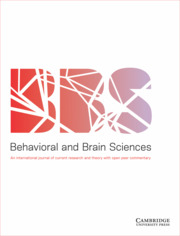Crossref Citations
This article has been cited by the following publications. This list is generated based on data provided by
Crossref.
Froese, Tom
Gershenson, Carlos
and
Rosenblueth, David A.
2013.
The dynamically extended mind.
p.
1419.
Reddy, Vasudevi
Markova, Gabriela
Wallot, Sebastian
and
Tsakiris, Manos
2013.
Anticipatory Adjustments to Being Picked Up in Infancy.
PLoS ONE,
Vol. 8,
Issue. 6,
p.
e65289.
Kourtis, Dimitrios
Knoblich, Günther
and
Sebanz, Natalie
2013.
History of interaction and task distribution modulate action simulation.
Neuropsychologia,
Vol. 51,
Issue. 7,
p.
1240.
Northoff, Georg
2013.
What is culture? Culture is context-dependence!.
Culture and Brain,
Vol. 1,
Issue. 2-4,
p.
77.
Gallese, Vittorio
2013.
Mirror neurons, embodied simulation and a second-person approach to mindreading.
Cortex,
Vol. 49,
Issue. 10,
p.
2954.
Grossmann, Tobias
Lloyd-Fox, Sarah
and
Johnson, Mark H.
2013.
Brain responses reveal young infants’ sensitivity to when a social partner follows their gaze.
Developmental Cognitive Neuroscience,
Vol. 6,
Issue. ,
p.
155.
Stanley, Damian A.
and
Adolphs, Ralph
2013.
Toward a Neural Basis for Social Behavior.
Neuron,
Vol. 80,
Issue. 3,
p.
816.
Jack, Anthony I.
Dawson, Abigail J.
Begany, Katelyn L.
Leckie, Regina L.
Barry, Kevin P.
Ciccia, Angela H.
and
Snyder, Abraham Z.
2013.
fMRI reveals reciprocal inhibition between social and physical cognitive domains.
NeuroImage,
Vol. 66,
Issue. ,
p.
385.
Krämer, Katharina
Bente, Gary
Luo, Siyang
Pfeiffer, Ulrich J.
Han, Shihui
Vogeley, Kai
and
Zalla, Tiziana
2013.
Influence of Ethnic Group-Membership and Gaze Direction on the Perception of Emotions. A Cross-Cultural Study between Germany and China.
PLoS ONE,
Vol. 8,
Issue. 6,
p.
e66335.
Gianelli, Claudia
Lugli, Luisa
Baroni, Giulia
Nicoletti, Roberto
Borghi, Anna M.
and
Paterson, Kevin
2013.
The Impact of Social Context and Language Comprehension on Behaviour: A Kinematic Investigation.
PLoS ONE,
Vol. 8,
Issue. 12,
p.
e85151.
Wiltshire, Travis J.
and
Fiore, Stephen M.
2014.
Social Cognitive and Affective Neuroscience in Human–Machine Systems: A Roadmap for Improving Training, Human–Robot Interaction, and Team Performance.
IEEE Transactions on Human-Machine Systems,
Vol. 44,
Issue. 6,
p.
779.
Kuzmanovic, Bojana
Schilbach, Leonhard
Georgescu, Alexandra L.
Kockler, Hanna
Santos, Natacha S.
Shah, N. Jon
Bente, Gary
Fink, Gereon R.
and
Vogeley, Kai
2014.
Dissociating animacy processing in high-functioning autism: Neural correlates of stimulus properties and subjective ratings.
Social Neuroscience,
Vol. 9,
Issue. 3,
p.
309.
Sevdalis, Vassilis
and
Keller, Peter E.
2014.
Know thy sound: Perceiving self and others in musical contexts.
Acta Psychologica,
Vol. 152,
Issue. ,
p.
67.
GarcÃa, Adolfo M.
and
Ibáñez, AgustÃn
2014.
Two-Person Neuroscience and Naturalistic Social Communication: The Role of Language and Linguistic Variables in Brain-Coupling Research.
Frontiers in Psychiatry,
Vol. 5,
Issue. ,
Schilbach, Leonhard
2014.
On the relationship of online and offline social cognition.
Frontiers in Human Neuroscience,
Vol. 8,
Issue. ,
Wiese, Eva
Müller, Hermann J.
and
Wykowska, Agnieszka
2014.
Social Robotics.
Vol. 8755,
Issue. ,
p.
370.
Konvalinka, Ivana
Bauer, Markus
Stahlhut, Carsten
Hansen, Lars Kai
Roepstorff, Andreas
and
Frith, Chris D.
2014.
Frontal alpha oscillations distinguish leaders from followers: Multivariate decoding of mutually interacting brains.
NeuroImage,
Vol. 94,
Issue. ,
p.
79.
Ansuini, Caterina
Cavallo, Andrea
Bertone, Cesare
and
Becchio, Cristina
2014.
The visible face of intention: why kinematics matters.
Frontiers in Psychology,
Vol. 5,
Issue. ,
Williamson, Kellie
and
Sutton, John
2014.
Brain Theory.
p.
107.
Hachmeister, Nils
Finke, Andrea
and
Ritter, Helge
2014.
Does machine-mediated interaction induce inter-brain synchrony? — A hyperscanning study.
p.
1018.



Target article
Toward a second-person neuroscience1
Related commentaries (28)
A mature second-person neuroscience needs a first-person (plural) developmental foundation
A second-person approach cannot explain intentionality in social understanding
Advancing the neuroscience of social emotions with social immersion
Brain games: Toward a neuroecology of social behavior
From synthetic modeling of social interaction to dynamic theories of brain–body–environment–body–brain systems
From the bottom up: The roots of social neuroscience at risk of running dry?
Further steps toward a second-person neuroscience
Interaction versus observation: A finer look at this distinction and its importance to autism
It takes two to talk: A second-person neuroscience approach to language learning
Merging second-person and first-person neuroscience
Mirror neurons are central for a second-person neuroscience: Insights from developmental studies
On projecting grammatical persons into social neurocognition: A view from linguistics
Parameterising ecological validity and integrating individual differences within second-person neuroscience
Reciprocity between second-person neuroscience and cognitive robotics
Second person neuroscience needs theories as well as methods
Second-person neuroscience: Implications for Wittgensteinian and Vygotskyan approaches to psychology
Second-person social neuroscience: Connections to past and future theories, methods, and findings
Social affordances in context: What is it that we are bodily responsive to?
Social affordances: Is the mirror neuron system involved?
Social cognition is not a special case, and the dark matter is more extensive than recognized
Social perception and “spectator theories” of other minds
Talking to each other and talking together: Joint language tasks and degrees of interactivity
The brain as part of an enactive system
The second person in “I”-“you”-“it” triadic interactions
The use of non-interactive scenarios in social neuroscience
Toward a neuroscience of interactive parent–infant dyad empathy
What we can learn from second animal neuroscience
Why not the first-person plural in social cognition?
Author response
A second-person neuroscience in interaction1